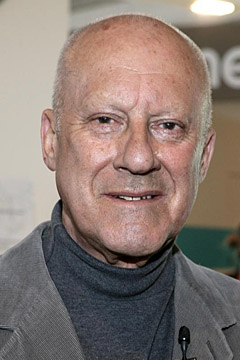
Lord Norman Foster will celebrate his 75th birthday
 |
Foster enjoys modern lightweight materials. He avoids traditional air conditioning in favor of natural ventilation. Futuristic airport terminals, skyscrapers, museums, and public buildings based on his designs are rising all over the world. He has also designed door handles, a wind turbine, and an electric bus powered partially by solar energy. His signature is most evident in the center of London.
Opened in 2004, Foster's building for the Swiss Re insurance company looks like a giant glass and iron cucumber that landed in London’s City near the Thames, earning the nickname from Londoners.
In the context of surrounding houses and churches, it resembles an object from an alien civilization. The 41-story tower consumes 50 percent less energy than similar buildings and utilizes daylight that flows in through its glazed sections.
His new City Hall is also made of glass and steel, situated on the opposite bank of the Thames like a massive tilted egg. It leans to the side at an angle of thirty degrees, thereby limiting the impact of sunlight from the south while maximizing light access from the north: "The lack of energy is a global problem. Instead of energy-intensive family houses, we need skyscrapers that can be built and operated as efficiently as possible."
As a "light knife cutting through the river," Foster envisioned a pedestrian bridge crossing the Thames in honor of the new millennium in 2000. However, the graceful footbridge unpleasantly swayed after opening, earning its creator the nickname Lord Wobbly.
In the reconstruction of the Berlin Reichstag, Foster wanted to cover the entire structure with a glass canopy. But that did not pass. So he at least proposed a roof in the form of a glass dome with a viewing ramp and an automatically controlled system of mirrors that illuminate the plenary hall. The dome also serves as an air reservoir for the natural ventilation system. It is surrounded by spiral ramps, providing not only a viewpoint but also a symbolic feeling of position above politicians.
In 2005, another Foster giant crossed the deep valley of the French Tarn River near Millau. Seven slender pillars rise into the sky like giant needles, connected by a system of strong suspension cables spanning a hollow nearly three kilometers wide: "Human endeavors must be in harmony with nature. The pillars must blend into the landscape as if they grew from the ground."
A virtuoso of British architecture grew up in a working-class neighborhood in Manchester among model airplanes and books on Le Corbusier's theories of space, light, and minimalism. At sixteen, he left school and served in the Royal Air Force (RAF). He earned money for later studies in architecture by selling ice cream. After finishing school, he traveled to the USA, where he "walked, drove, and took the bus" to visit as many buildings by Frank Lloyd Wright as possible, determined to bring their graceful curves and natural light to formal Britain.
His star rose on the British scene in the 1960s. In 1964, he created a glass bubble in Cornwall, a building partially sunk into the ground called the Cockpit. In 1970, he designed the world's first inflatable bank building as part of Foster and Partners - a translucent object made of nylon and PVC.
In 1990, Foster was elevated to the peerage. However, critical voices regarding him can also be heard in Britain. He is said to be in too privileged a position. Critics accuse him of an obsession with steel, aluminum, and glass.
Currently, the renowned architect mostly supervises his team. Otherwise, he enjoys traversing the country on skis or by bicycle and pilots gliders, helicopters, and jets, including a Boeing 747. His short gray hair gives him the appearance of a Roman senator. His third wife, Elena Ochoa, is a Spanish psychologist. Sir Norman has five children. And last year he received the prestigious Prince of Asturias Award for Arts for 2009.
The English translation is powered by AI tool. Switch to Czech to view the original text source.
0 comments
add comment





